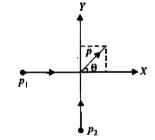A body of mass 5 kg moves along the x-axis with a velocity of 2ms−1. A second body of mass 10 kg moves along the y-axis with a velocity of √3ms−1. They collide at the origin and stick together. Calculate
The final velocity of the combined mass after collision.
p1=10kgms−1,p2=10√3kgms−1
p=√102+3(10)2=20kgms−120=(5+10)v
v=4/3ms−1.

Initial K.E.=(1/2)[5×22+10×3]=25J
Final K.E.=(1/2)(10+5)(4/3)2=(40/3)J
Heat generated =25−(40/3)=(35/3)J.
Topper's Solved these Questions
- DYNAMICSBOOK - ICSECHAPTER - DYNAMICSEXERCISE - SHORT ANSWER QUESTIONS WITH ANSWERES
43 Videos
- DYNAMICSBOOK - ICSECHAPTER - DYNAMICSEXERCISE - SHORT ANSWER QUESTIONS WITH ANSWERS
12 Videos
- DYNAMICSBOOK - ICSECHAPTER - DYNAMICSEXERCISE - VERY SHORT ANSWER QUESTIONS
60 Videos
- DIMENSIONSBOOK - ICSECHAPTER - DIMENSIONSEXERCISE - SELECTED PROBLEMS (FROM CONVERSIONS OF ONE SYSTEMS OF UNITS INTO ANOTHER)
9 Videos
- FRICTIONBOOK - ICSECHAPTER - FRICTIONEXERCISE - Selected problems
30 Videos
Similar Questions
Two bodies of masses m and 2m are moving along positive x and y axes respectively with equal speed 4ms−1. They collide at origin and stick together. The final velocity of combined mass is
View SolutionTwo bodies of masses m and 2m are moving along positive x and y axes respectively with equal speed 4 ms−1. They collide at origin and stick together. The final velocity of combined mass is
View Solution
Knowledge Check
A body A of mass 5kg is moving along the x-axis with a velocity 2m/s. Another body (B) of mass 10 kg is moving along the y-axis with a velocity √3m/s. They collide at the origin and stick together. What is the final velocity of the combined mass?
A√3m/sB(√3+1)m/sC43m/sD2(√3+1)m/sTwo bodies of masses m and 2m are moving along positive x and y axes respectively with equal speed 4ms−1. They collide at origin and stick together. The final velocity of combined mass is
A(4ˆi+8ˆj)ms−1B(43ˆi+83ˆj)ms−1C(43ˆi+8ˆj)ms−1D(4ˆi+83ˆj)ms−1A body of mass 3kg moving with a velocity of 4m/s towards left collides head on with a body of mass 4kg moving in opposite direction with a velocity of 3m/s. After collision the two bodies stick together and move with a common velocity which is
AzeroB12m/s towards leftC12m/s towards rightD127 m//s towards left
A body of mass 3kg moving with a velocity of 4m/s towards left collides head on with a body of mass 4kg moving in opposite direction with a velocity of 3m/s. After collision the two bodies stick together and move with a common velocity which is
View SolutionA body of mass 2 kg moving with a velocity of 3 m/sec collides head on with a body of mass 1 kg moving in opposite direction with a velocity of 4 m/sec. After collision, two bodies stick together and move with a common velocity which in m/sec is equal to
View SolutionA body of mass 2 kg moving with a velocity of 3 m/sec collides head on with a body of mass 1 kg moving in opposite direction with a velocity of 4 m/sec. After collision, two bodies stick together and move with a common velocity which in m/sec is equal to
View SolutionA body of mass 2 kg moving with a velocity of 3 m/sec collides head on with a body of mass 1 kg moving in opposite direction with a velocity of 4 m/sec. After collision, two bodies stick together and move with a common velocity which in m/sec is equal to
View SolutionA body of mass 2kg moving with a velocity of 3m/sec towards left collides head-on with a body of mass 3kg moving in opposite direction with a velocity 2m/sec. After collision the two bodies stick together and move with a common velocity which is :
View Solution
